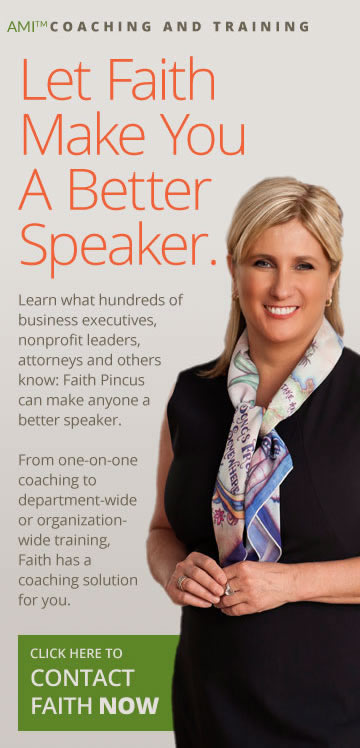Using Better Handouts and Power Point at CLEs
About a week ago I read Jennifer Ellis’ great post, “PowerPoint Peeves of a CLE Provider.” I loved it! She hit a lot of my usual gripes, but the most important point she makes is this:
- If you’re using Power Point, never, under any circumstances, write your presentation using Power Point.
Here’s the deal, as I mentioned before and will again, and again and again, until I stop seeing those god awful Power Point slide decks that obviously serve as the speech outline:
Power Point is a Visual Aide. It is not your presentation.
And this applies to any presentation, not just CLE programs for attorneys.
Create your presentation first, practice it, put it in a short outline format (key words and phrases, not full sentences or written out speech). Then, and only then, do you look at it and decide where you could use visuals to enhance your message.
And then – go find good visuals!
For example, I am giving a webinar tomorrow with Kevin O’Keefe for LexBlog: Public Speaking for Business Development. This program is a twist from my usual public speaking presentations, so I sat down a few weeks ago and put together my first draft full sentence outline. I then reviewed it a few times, massaged it, condensed it and wrote a list of the main points in the presentation that could use some sort of visual.
A few days later I spent time on the internet and in my cartoon files finding the right visuals to reflect the message I will be presenting. Then I created the Power Point slide deck that will go with my presentation, not be my presentation.
That’s the process you want to go through.
For inspiration, check out the books: Presentation Zen and Slideology, which I have mentioned before (yes I wish I’d written one of these instead of just griping about Power Point for the last ten years).
When I am forced to use Power Point, as I do in Public Speaking Webinars, I usually search istock, have custom cartoons made, or use cartoons I purchase a license too, like the one here. If you are interested in contact info for custom cartoonists, email me or post a comment and I’ll send you the phone/email of the three folks I recommend.
Jen’s second most important point:
A copy of your slides is not an effective, or helpful, handout.
Amen.
If you are going through the trouble of creating a presentation and taking time out of your busy day to present, do it right. Please. You risk hurting yourself and your reputation if you don’t (as well as the CLE provider’s reputation).
Generally speaking, attendees want the following (at least at our CLE programs):
- Exemplars
- Tip sheets / to-do lists
- Check lists
- Time lines/chronologies
- Case lists (especially if you are citing any)
- Important Rules to remember
- A topical outline (but don’t read it!)
- A list of additional resources and articles they can look up if they want
Some of the best handouts I ever received for one of our CLE programs were from a small firm firm Plaintiff’s attorney, Darci Burrell, with all women law firm Dickson Levy Vinick Burrell Hyams LLP (check out their great Web Page with Rosie the Riveter on it!).
Darci gave us her trial prep check lists – about 10 of them – and they were comprehensive and incredibly helpful. This was for our 5th Annual Superior Court Boot Camp, where most of the attendees were new/newer attorneys. We’ll be putting this program on again by the way, this fall and Darci was definitely invited back (and has agreed to join us)!
A copy of a Power Point presentation just isn’t as helpful as thoughtful handouts that will provide a resource the attendees after the program.
Good handouts are an easy thing to have an associate or secretary help you put together based on your presentation. And always make sure you have contact information on your handout on a title page, as well as in a footer, in case pieces of the handout get passed out separately.
Remember, good handouts have longevity as does your contact information on them.

-thumb-200x274-9215.jpg)
